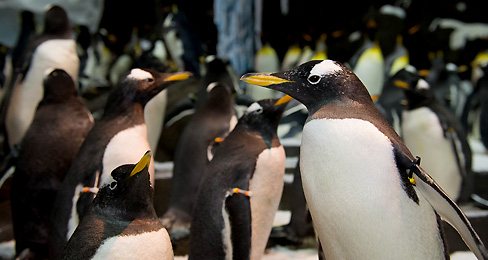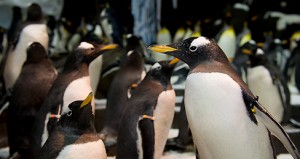Sea World’s New Friends

By TFK Kid Reporter Alaa Osman
Sea World Orlando has a new attraction. It’s called Antarctica: Empire of the Penguin. I got to visit the Florida theme park on opening weekend to learn all about it. The exhibit features nearly 250 penguins, including Adelie and rockhoppers. I even got to pet one! The animals all live together in an environment made to look and feel like the icy cold continent to the south. At an underwater viewing section visitors can see the penguins dive and swim. There’s also a fun ride for families to enjoy together. It’s a motion simulator that allows guests to follow the adventures of a penguin named Puck as he explores the harsh, yet beautiful, Antarctic landscape.

During my visit to SeaWorld Orlando, I sat down with Anita Schiavoni-Gibbons. She’s an aviculturist, or bird expert. I talked with her about her job, the making of the exhibit, and how the park cares for all those penguins. I also learned how climate change affects the penguin’s habitat and what humans can do to help the environment.
TFK:
Why did SeaWorld want to make an exhibit about penguins?
ANITA SCHIAVONI-GIBBONS:
Who doesn’t love penguins? We’ve had penguins at SeaWorld Orlando since 1987. But we wanted to build a great new exhibit that would be family-interactive, where the guests can see the penguins up close and feel the environment and actually hear them. In the old exhibit you were separated by glass, so you couldn’t really hear them or feel the temperature. So this is a whole new experience.
TFK:
How did SeaWorld recreate Antarctica in Orlando? What were some of the challenges?
SCHIAVONI-GIBBONS:
Well, in recreating Antarctica, there was a team of designers that actually did all the research they could about what Antarctica looked like and felt like. So all that research, as well as our input, created this exhibit in mimicking the rock work that you would see in Antarctica, the snow, the feel of the cold, and the cold water as well. Some of the challenges were making sure the rock work was just right, that it wasn’t too rough for the penguins’ feet, or that it wasn’t too smooth for them. They like to climb on the rocks, so we wanted to make sure they could grip it and climb up on it.
TFK:
How are the penguins cared for?
SCHIAVONI-GIBBONS:
We go and mainly observe them with our eyes and our ears. If one’s sleeping more than normally or seems squinty-eyed [and] we think maybe something may be going on, we might have a vet check on them. We also feed them everyday with restaurant-quality fish. We feed them capelin, herring, lake smelt, and silversides. We feed them in the water so that they’re feeding naturally, but we also have trays of fish out, on top of the snow, because we have a lot of older birds that may not get to the water so quick, so they can feed out of the trays.
TFK:
What is similar about the penguins’ natural habitats and their homes at SeaWorld? What is different?
SCHIAVONI-GIBBONS:
It’s very much the same, other than the scope of it. Obviously Antarctica is huge, so this is a sample size of it. For the number of birds that we have, which is nearly 250, it’s a great representation of what you would get if you went to Antarctica. To go to Antarctica is very expensive, and it’s a very long trip. Most families can’t experience that, so here at SeaWorld it’s been recreated so the entire family can experience what Antarctica would be like.
TFK:

In their lifetime, what hardships does the average penguin face?
SCHIAVONI-GIBBONS:
In their lifetime, penguins face predators, which they don’t have here [at SeaWorld]. There are large ocean-dwelling birds that would feed on the eggs or the chicks of penguins, as well as whales and sea lions. So they don’t have natural predators, and obviously here in this environment they have veterinary care, should they need it, where they wouldn’t have that in the wild.
TFK:
Does each species have different needs?
SCHIAVONI-GIBBONS:
For the most part, all the penguin species have the same needs. Just like us, [they need] shelter, warmth, food, and water. We’ve provided that here, and they do very well with that.
TFK:
Why did you choose a career as an aviculturist?
SCHIAVONI-GIBBONS:
I just decided I really liked birds. One of my first experiences with birds was when I lived in Texas as a first grader. I found a little mourning dove on its back in my backyard. I actually took it and put it in a shoebox. It must have hit a window. As I’ve grown older and learned about birds, [I realized that the bird] was just stunned for a little bit, but it flew off.

TFK:
The ice in Antarctica is rapidly melting. What effect does this have on penguins?
SCHIAVONI-GIBBONS:
That’s a great question. The penguins feed out of the ocean. Their food source is the fish. As the water warms up, the fish that normally live in that cold water don’t survive, or they move on, so the penguins have to follow the food source. Some of them can adapt to a change in the environment. There are some species, like the Adelie and the emperors, which are restricted to Antarctica, so they really want that cold. As global warming heats up, they really have no place to go since that’s the coldest place on Earth.
TFK:
How is SeaWorld helping to increase awareness about climate change? How can people help?
SCHIAVONI-GIBBONS:
Doing simple things, like not polluting. Don’t do a lot of driving if you don’t have to. Just be aware of your environment around you, picking up trash as you go around. Especially in the ocean, a lot of plastic gets in the environment, and any animal that eats plastic, it makes them sick and some of them die from it because they can’t digest it. So just getting up on the beach, just cleaning the environment up, and just paying attention to what’s happening around you. Get your community involved. [As you] walk through your neighborhood, [pick] up trash, because everything leads to a waterway. You know your little storm sewers in your neighborhood? The rain goes down, and that leads to a lake or a river, which can then lead to the ocean. Everything has a consequence.
Source: http://www.timeforkids.com/news/seaworlds-new-friends/94966


